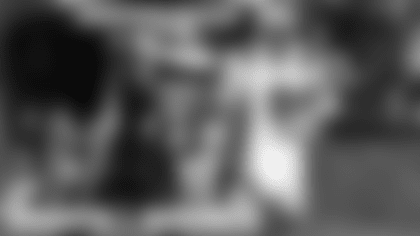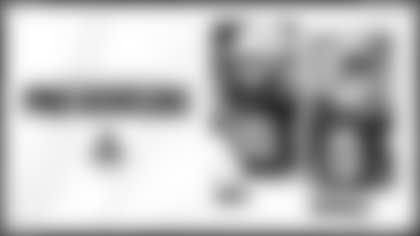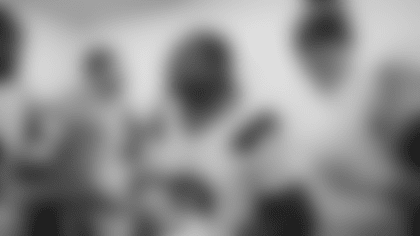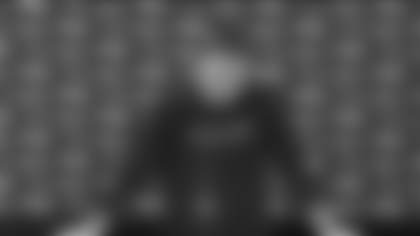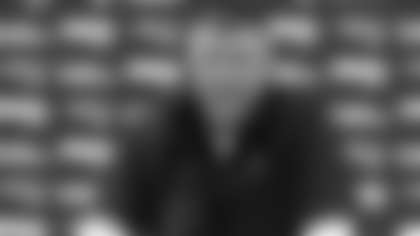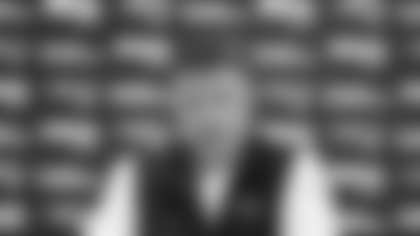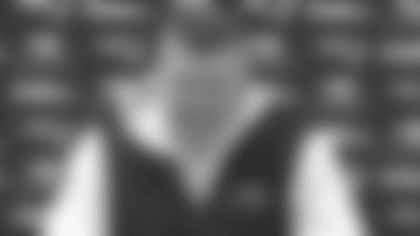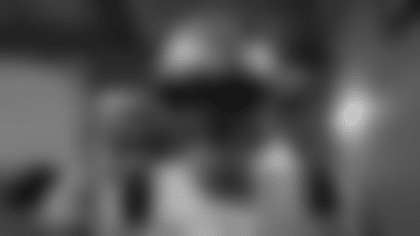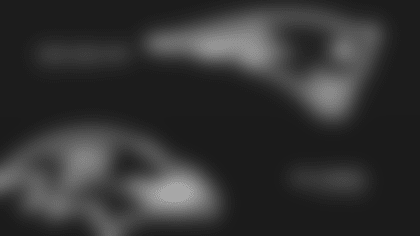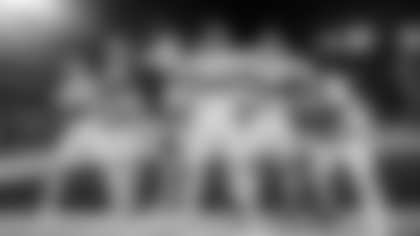**
BB:** Rolling on these Raiders. It's a lot of familiar faces, but guys who we've been used to seeing in different uniforms. I think the thing that jumps out about the Raiders is how experienced they are, how many veteran players they have. As usual, they're a big, fast team. In the kicking game, they have a lot of guys who are big and can run. They've got two big kickers: [Sebastian] Janikowski and [Marquette] King. Those guys can kick it as far as anybody. We're going to have to do a good job there with field position and ball handling and so forth. Offensively, [Derek] Carr is clearly taking control. He's been impressive; gets the ball out quick, makes quick decisions, athletic. The run he had against Houston last week was impressive. [He] spreads the ball around – receivers, backs, tight ends. Good running backs – two different type of guys with [Maurice] Jones-Drew and [Darren] McFadden, but both good; different styles. [Marcel] Reece is obviously a matchup guy. Big offensive line, real big. Two rookies they have on offense there, [Gabe] Jackson and Carr, have done a good job for them. Then the same thing with [Khalil] Mack on defense and the group that they've added in the secondary plus [Justin] Ellis. A lot of experience on defense; [they've] almost redone their whole defensive line with [Justin] Tuck, [LaMarr] Woodley, the kid from Green Bay [C.J. Wilson], Mack, obviously. They've added a lot there and same thing in the secondary with the two corners from San Francisco – [Tarell] Brown and Carlos Rogers and of course [Charles] Woodson is extremely impressive. Woodson really doesn't look like a 17-year veteran, I'll tell you that. He makes plays all over the field – very aggressive, fast, instinctive, strong tackler, tough. Just couldn't say enough about how impressed I've been watching him on film. Raiders have real good team speed. They're a big, physical team. We have a lot to get ready for in terms of their scheme and personnel. I think Coach [Dennis] Allen has done a good job there defensively with emphasizing the turnovers. They caused a lot of fumbles last year. I think it was the fourth-most in the league or something like that. They do a good job of turning the ball over. They've done a good job offensively of scoring in the red zone and really not turning the ball over much in two games. We're going to have to play good, solid, physical 60 minutes of football on Sunday. That's what we're expecting, that's what we're looking for.
Q: After their game, Charles Woodson described how he felt about his team and how they played Sunday. Obviously they were negative words. From what you've seen on the tape, why would he be so down on their performance? What didn't they do on Sunday?
BB: They fell behind early and then just were kind of never really that close…Houston was able to just stay far enough ahead, a couple touchdowns ahead. Look, we've all been there before. Last week is last week. It doesn't really mean anything. I'm sure that based on the comments that I've seen out of there and the leadership that they have on that team, the veterans that they have on that team, I'm sure that we'll come in here and we won't see the team we saw against Houston last week. That's what we're getting ready for – we're getting ready for their best game and I don't think Houston was probably it.
Q: How are you addressing the problem you've had with penalties?
BB: Yeah, we have to do a better job. We've talked about them, we're practicing. We just have to do a better job.
Q: The Raiders pass defense is ranked second in the league, I think. They're only giving up like 165 yards per game. Does it start with the defensive line? Obviously, the veteran experience in the secondary. What kind of challenges do they present?
BB: Yeah, all of it. They have a good pass rush, they've got several good rushers – [Antonio] Smith is very disruptive up there, [Pat] Sims, Mack, Woodley, Tuck. They do a good job up there. They have good coverage players. They have a lot of, six, seven corners on the roster. I guess it's six now because they IR'd one, but they've got good coverage players back there. [TJ] Carrie has done a good job for them, then they got [Chimdi] Chekwa back last week, of course to go with Brown and Rogers. Woodson really is a corner, even though he's playing safety. Tyvon Branch [is] one of the fastest players in the league; Sio Moore. They have real good team speed, good man-to-man coverage team. They cover receivers, tight ends, [have] a good pass rush. That will be a big challenge. Getting away from those guys has been tough for teams that have played them. Even in preseason, people, the teams they played in the preseason – Seattle, Minnesota – they just get up on the receivers and there's not a lot of space between the defender and the receiver. The quarterback has to make a tight throw, the receiver has to make a good catch. It's hard. And they've got a good pass rush.
Q: Is Khalil Mack pretty much the player everyone thought he could be?
BB: He's been disruptive. They play him at linebacker in their regular defense and then in sub – it's a little bit like [Minnesota linebacker Anthony] Barr. In sub, they played him more as a defensive end. Minnesota was playing Barr at linebacker and end. It looks like they've committed more to really end with Mack. But he's fast, he's explosive. He's got a lot of talent and he's certainly made some good plays. Like any rookie, he's got a lot to learn, but he's a force out there.
Q: Schematically, how would you describe what Jason Tarver is trying to do with their defense? How is it different from what you've seen Kevin Coyle and Mike Zimmer do the past two weeks?
BB: I'd say they play more man-to-man, more press coverage. They mix their mans and their zones. They mix some pressure in there, more man pressure probably than zone pressure. So, I'd say more man-to-man than we've seen the last couple weeks. Although, we've seen our share of man-to-man, too. Certainly Minnesota gave it to us. But, you know, they mix it up. Coach Allen has a bunch of different packages, pressure packages. But in the end, you have to block the guys up front. It starts there. That will be a big challenge for us. But they've got a good mix with I'd say a good amount of man-to-man.
Q: As it pertains to the possible drug policy, have you gotten any further guidance from the league and what that could mean for your players?
BB: No. You have to talk to the league about that. We don't know anything. It's a very confidential policy and it's really handled between the league and the players. Coaches are really out of it. I'm like Sergeant Schultz [from Hogan's Heroes]. I don't know anything.
Q: So they don't give you any guidance.
BB: I don't know. I know nothing. Zero.
Q: So no indication whether you could have a player or two back this weekend?
BB: No idea. Nope. Until we get notified of anything, we get notified of anything.
Q: What do you see from their receiving corps? It seems like they have a couple of fast guys in Rod Streater and James Jones.
BB: Well, you know, Jones I'd say in particular, is very athletic. He has a lot of acrobatic type catches, too. He has great timing, leaping ability and big hands. He's been very, I don't want to say go-to guy, but they've gone to him. I mean, the catch against the Jets was a tremendous play to even make the catch, then to get his feet in bounds and all that. He's a very good receiver, that's a big target, that's got a big catch radius, got great hands and great jumping ability.
Q: Are there certain fundamental elements that you see even though coaches change when it comes to Oakland Raiders football?
BB: I think that this team looks like the big, fast team that the Raiders have historically been known for, yes. They're big at every position – their line is big, their receivers are big, backs are big, defensive line is big, secondary is big, kicker is big. They're fast. I don't know how many guys they have run under I'd say 4.4, 4.5, but it has to be a dozen, maybe more than that. I don't know. There's a lot. They're fast at linebacker, they're fast – DBs are all fast. Even the safeties are fast. [Usama] Young is fast, obviously Woodson is fast. Tyvon Branch is sub-4.4. These guys can all – they have a big, fast team. You see it in the kicking game. You see it certainly defensively. Teams that try to run outside and bounce the ball out on them, it's not one guy making the play. It's like four guys that are out there before the back gets out there. They have very good team speed. Overall, they're big. I don't know what their offensive line, I don't even know what they list them at, but just looking at them, they have to average 340 [pounds]. They're huge. It looks like the Raiders. Maybe they look bigger in those black uniforms, I don't know.
Q: When you have a team that has two disappointing outcomes in the first two weeks, do you anticipate a desperate team?
BB: That's the first thing I said. I think with the leadership out there, the veterans that they have on that team, guys that are used to winning, guys that they've brought in that have been in all those playoff games and Super Bowls and all that, I'm sure that they're – I mean look, this is where we were a week ago. This is the same thing we heard in here last Wednesday or whenever it was, after the Miami game. I'm sure they feel after the Houston game the way we felt after the Miami game. Last week doesn't mean anything in the NFL. It's what happens this week. That's all we can focus on is what we can do to get ready for this game. We have a lot to get ready for. They have a lot of good players, good team, and they have a lot of pride; they have a lot of toughness. It's going to be hard.
Q: For a wide receiver, is successfully executing the pick play or rub play one of the more difficult things they have to do?
BB: I don't know about that.
Q: Would you say it's tough?
BB: I'd say it's tougher on third-and-five if you get up there with a good corner that's lining up six inches away from you and get open to get the first down. I'd say that's what a good receiver has to do to be a good receiver, is to be able to beat tight coverage in situations where they know you're throwing to them and you know you're throwing it to them. You have to get open and you have to catch the ball. You have to catch it against tight coverage. I'd say that's the hardest thing a receiver has to deal with. That's what all the great ones can do. If they can do that, if they can get open in critical situations against tight coverage and make great catches when the defenders are all over them, that's what I look for in a great receiver.
Q: Can you teach the one-handed catch? The reason I bring it up is there were so many spectacular one-handed grabs this week. Is that the expanding of the catch radius? Is that something you can coach?
BB: We coach catching all the different types of balls that a receiver can catch: high, low, to the side, in front of him, behind him, over the shoulder, trying to have to torque his body and adjust to the catch, one-hand, two-hand, all those. It's repetition, experience and concentration. Certainly skill is part of it as well. I wouldn't underestimate that. Yeah, that's all part of it. We do that on a daily basis – before practice, after practice. Those guys probably catch over 100 balls a day one way or another. It's not just standing there playing catch; putting the ball in different locations, having to extend and use their hands and not being able to body-catch it. Again, with the ball behind them, with the ball in front of them, high, low. Yeah, that's what they do. They catch a lot and work a lot on their ball skills and their catch skills in all different locations.
Q: How do you coach the rub play with so much of an emphasis on contact down the field and illegal contact?
BB: Well, the rules really haven't changed. You're talking about pass defense or offense?
Q: When your guys are running the rub play.
BB: As an offensive player, you have an entitlement to space. As a defensive player, he has entitlement to space. It's a question of, if there's contact, how the officials view the contact as to if you're trying to run a pattern and there's incidental contact or you're trying to interfere with the defender who is trying to cover somebody else. That rule really hasn't changed. It's not a new rule. We have to do it in a way that we're entitled to run the route that we're running. We have to do it in a way that it isn't a foul relative to what the defenders are doing. We have to coach it better, we have to execute it better and we have to eliminate all the penalties; that one and all the other ones, too. That was one and there were 17 other ones. We have to do a better job on all those.
Q: You mentioned that Marcel Reece is a matchup player. Why would you call someone a matchup player?
BB: It's hard to find somebody to cover a player like that. You put a big guy on him, he probably is going to have a hard time matching up with Reece's speed and quickness. You put a smaller guy on him, he might match up with his speed and quickness, but it would be hard to match up with his size. I'd say that's a dilemma. Who do you have that has the same skill set as Reece? He was a former receiver and now he's a fullback. You have a linebacker covering a receiver; you have a DB covering a fullback. That's kind of what you're looking at. You can't double a guy on every play, but somewhere along the line somebody has to cover somebody. I think it's hard to match up against a guy like that, that just has a real good skill set that defensively, it's hard to find people that can match that.
Q: Watching Indianapolis the other night, they used a lot of unbalanced formations, putting the tight end at tackle and shifting the other side of the line. You've used a lot of tackles as tight ends recently. Is there an advantage of one over the other in terms of what you can do?
BB: I'd say the main issue you get into would just be the commitment you make to it. Putting an offensive lineman in for a tight end, I would say you're going to get less of a defensive adjustment, normally. I would say you'd get less of a defensive adjustment because the spacing is still the same, it's just who is that guy? It's a lineman instead of a tight end, but if it was a blocking tight end or lineman, how much difference is there? I'd say there's a smaller degree of grade of adjustment for the defense. Once you flip a lineman over, now you've totally changed the defensive spacing. What was a three-man surface is now a four-man surface. What was now a three-man surface is now a two-man surface. That creates some fundamental blocking angles potentially for the offense. I'd say that there's a lot more involved in that. The issues you get into offensively are things like protections where, here's our rule on protections but now we're in a different look so how do those rules change, how do our assignments change? I'd say normally you'd have to simplify your protections quite a bit rather than try to run them all from an unbalanced line. I'm not saying you couldn't do it, but it would take a lot of work, I would think. The same thing defensively, once they unbalance, then you have to decide how you want to handle the – normally, say you have three guys to one side of the center and two guys to the other side, but the two guys to the other side are ineligible. Now you put a guard and tight end on the two-man surface and then you get three offensive linemen on the three-man side, it changes your passing strength. It changes the surface that you have to defend defensively and it changes the location. Normally that two-man side is ineligible so now you've kind of flipped that around so there are some things you have to handle defensively. But I think it certainly limits you some offensively. Some of your weakside runs that you were running behind a tackle, now you're running behind a tight end, so you have to know where there defense is going to be when you call some of those plays, which gets again, a little bit more involved. I think it's hard to be in an unbalanced line and just run one or two plays because you don't know if the defense is going to move over or not move over, rotate away from the formation passing strength, rotate to it. You know, there's too much uncertainty. But, if you have a number of plays then no matter what they do then theoretically, just like everything else in your offense, you can, 'If they do this, we do that. If they do that, we do this.' So, you need some kind of volume to be able to handle that unless you just want to run one or two things as a changeup just to kind of make the defense work on it. I don't want to say it's a whole different offense but it definitely presents some different problems for you. In order to be good at it, you would have to commit a decent amount of time and scheme to it so that if the defense does this, we have that advantage. If they don't, rather than if we go over and, 'Here's what we think they're going to do but, oh, they didn't do it, now we're stuck.' When you're in that kind of situation it's kind of not worth it.
Q: You see that a lot in option football it seems.
BB: Again, in the running game it's much easier to handle in the running game, particularly if you check the play. So if they move over, then we can come back here. If they don't move over, then we have the advantage to the overload side and we can go that way. I'd say that's a lot easier. Once you get into the passing game and a lot of protections and 'Who is the linebacker?' when you're on the two-man side, you're not thinking usually about a secondary player being over there. I'm not saying he couldn't, but that's infrequent. The secondary player is usually over on the three-man side where the tight end is. Now you've got him on the backside, now who's got him, what's the quarterback's read? There are some things you have to handle. If you're running away from them, then great, it doesn't matter. I think when you get into the read-option game or the triple-option game or that type of, then that's kind of a different ballgame. But it's certainly an interesting aspect going all the way back to the single-wing days. That was the whole single-wing offense was the balanced single-wing, then the overloaded single-wing then the box shift back to the weakside. It was all overload blocking angles trying to create. I don't think the plays were checked back then. You were just trying to show power over here, now you've got power over there and show power over here and run counter back the other way and all that. That's really what football was in the '40s; '30s and the '40s. That was a huge part of the game. It's interesting to see how all that, how they tried to handle those different things, both offensively and what they tried to create and defensively what the answers were to them.
Q: Do you ever wish you could coach back then?
BB: In a way I really feel lucky because the one year, in eighth grade I played for the T-Birds in Annapolis. It was the Ford dealership. I think it was 110-pound football and so we were the T-Birds and so our coach played college football at Clemson so we ran the single-wing. That was our offense. Whatever year that would have been, call it '62, somewhere in there, '63, whatever it was. So, for a whole year I got to experience what a single-wing offense was. It was pretty interesting, just being a lineman, which that was the game really, was the blocking play, the blocking patterns and the calls. That's kind of all he knew, was to run the single-wing. So we ran the single-wing. Really looking back on it, it was a great experience I never would have gotten otherwise just because it was kind of going out of, hardly anybody was running it. Lawrenceville ran it and when I played at Andover in 1971, Coach [Ken] Keuffel down there, I think he might have been the last one to run the single-wing because he ran it all the way through his career at Lawrenceville. So we actually played against it when I was in high school. The principles and the elements of it are interesting. I'm glad I got to experience it. I got to experience the wing-T in high school, the single-wing in Pop Warner football, the Wishbone in college and my exposure to all the NFL stuff since '75. I feel very fortunate to have the opportunity to at least experience those systems in addition to the college stuff and all that Navy did and I did with my dad and so forth. Other than UCLA, Tennessee, they were kind of the last, if I remember right, Clemson, were some of the last teams that hung with the single-wing but then by that time it had all gone to wing-T, which was another interesting transition because all those single-wing teams in the '50s had to make a decision when they went to the T-formation what they were going to do with the tailback, which when all those guys came into the NFL, was the decision the NFL had to make with them. Paul Hornung, you put him at running back. Johnny Unitas, you put him at quarterback; Bill Wade, you put him at quarterback. You had single-wing tailbacks that ended up becoming halfbacks in the NFL or they became quarterbacks in the NFL because that was their combination job in the single-wing offense. Of course, nothing was more important than punting so the great single-wing tailbacks like Sammy Baugh, punting was really such a big part of it then that your single-wing tailback had to be a good punter. Then he had to be able to run and the third thing was to be able to throw. When those guys came into the NFL, the NFL had to make a decision as to whether they were going to make those guys running backs or whether they were going to make them quarterbacks. So guys like Johnny Unitas and Bill Wade and [Charlie] Conerly and guys like that, they were all tailbacks that became quarterbacks. Pretty big guys, a guy like Unitas, he was 220 pounds. Wade was 215, 220. They were big guys; they weren't like the Fran Tarkenton type. They were big guys that could run. They just weren't fast enough. Then the runners like the Hornungs stayed as runners.
Q: How did the T-Birds do?
BB: We were OK. Who did we lose to? I think we lost to Elks or somebody like that. Those were big tilts there in Annapolis.




